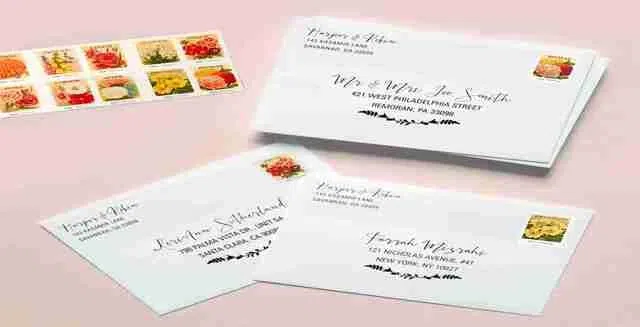
One of the most crucial yet frequently ignored aspects of wedding planning is learning how to correctly address wedding invitations. The way you address your wedding invitations reflects the formality of your occasion and demonstrates respect for your guests. Whether you're throwing a classic or modern or digital wedding invitation, taking the effort to properly address your invites creates a lasting first impression. This article will teach you all you need to know about how to handle formal wedding invites, family invitations, and unique cases.
Why Properly Addressing Wedding Invitations Matters
When planning a wedding, it's tempting to get caught up in the big picture, such as selecting a venue or compiling a guest list. However, knowing how to properly address wedding invitations is an important aspect that will enhance your visitors' overall experience. It establishes the tone for your gathering and emphasizes the formality of the occasion. Correctly addressing your invitations also helps to prevent confusion and misinterpretation regarding who is invited. If you’re using a wedding invitation service, ensuring that these details are accurate will further ensure that your invitations reflect the elegance and respect you want to convey.
Properly sent invites demonstrate respect and concern for your guests. It demonstrates that you've considered every part of your wedding, down to the slightest detail like addressing envelopes. How to address wedding invitations entails more than just writing names; it is about recognizing the relationships you have with your guests. Providing accurate titles, spellings, and names provides a personal touch that your guests will appreciate.
Basic Guidelines on How to Address Wedding Invitations
Before we get into further specifics, let's start with the fundamentals. Here's a rundown on how to address wedding invites so your envelopes seem lovely and professional:
Use Full Names:
Always use entire names on envelopes. Avoid nicknames and acronyms, which might make your invitation appear too informal. For formal invitations, utilize titles such as "Mr.," "Mrs.," and "Dr."
Addressing Couples:
If you're inviting a married couple with the same last name, address them as "Mr. and Mrs. John Smith." If they have distinct last names, write each name separately, for as "Mr. John Smith and Ms. Jane Doe."
Including Professional Titles:
If one or both of your guests have professional titles such as "Dr." or "Captain," include them. For example, "Dr. Emily Brown" or "Captain John Taylor" are appropriate.
Avoid abbreviations:
Spell out words like "street," "avenue," and "boulevard." When writing formal invites, avoid using address or state abbreviations.
Following these recommendations ensures that you properly address wedding invites, giving them a polished, polite appearance.
How to Formally Address Wedding Invitations
If your wedding is traditional, you should take particular care while addressing wedding invitations. A formal approach respects the traditions and decorum required for a formal gathering. Here's a brief overview of many scenarios:
Married Couples:
Use either "Mr. and Mrs. John Smith" or "Mr. John Smith and Mrs. Jane Smith," depending on the couple's preference. It is appropriate to use the wife's full name if you are aware of her preference.
Single Guests:
Addressing a single guest is straightforward; simply mention their entire name and title. For instance, "Mr. Robert Anderson" and "Miss Emily Johnson."
Guests with Professional Titles:
Prioritize professional titles when sending invitations. For example, "Dr. Sarah Thompson and Mr. David Thompson" would be correct format when addressing a married couple where one is a doctor.
Taking the time to figure out how to formally address wedding invitations shows your guests the importance of their presence at your wedding.
How to Address Wedding Invitations to a Family
One of the more difficult components of wedding invitations is determining how to address them to a family. Here's some advice on how to tackle it:
Include Children:
If you are inviting children, their names should be added below the parents' names. For example: Mr. and Mrs. John Smith.
Emily & Andrew Smith
This clearly indicates that children are included in the invitation. If you aren't inviting children, simply address the mail to "Mr. and Mrs. John Smith" to indicate that only the parents are invited.
Blended Families:
If you're inviting a family with children from many marriages, list their names separately under the parents' names. This demonstrates respect for each member of the family and prevents confusion.
Knowing how to address wedding invitations to a family is essential for ensuring that everyone feels included and understands who is invited.
Addressing Special Cases in Wedding Invitations
Not all invitations conform to the usual family or marital relationship. Here's how you handle special cases:
Same-Sex Couples:
Apply the same rules as opposite-sex couples. If you are unsure which name should be put first, alphabetical order is a safe bet. For example:
Mr. Alex Green and Brian White
Unmarried couples:
If you are inviting an unmarried couple who lives together, write their names on separate lines. For example:
Mr. John Williams
Divorced guests:
Please use their preferred name and title. For example, "Ms. Sarah Thompson" refers to a divorced lady who has decided to preserve her married name.
Handling these unique situations with care ensures that all of your guests feel appreciated and cherished.
Conclusion
Knowing how to address wedding invitations correctly gives a personal and respectful touch to your wedding. Whether you're learning how to professionally address wedding invites or how to send wedding invitations to family members, attention to detail is essential. By adhering to the standards outlined above, you can guarantee that each attendee feels acknowledged and that your invitations match the tone of your event.
Taking the effort to properly address your invites sets the tone for your wedding and makes a great first impression. Regardless of the formality of your event, mailing your invites with care demonstrates to your guests the importance of their attendance on your special day. If you want learn more about wedding invitation tips,check out our blog Crafting Wedding Invitations: Wording Tips, Examples, and Simple Designs

